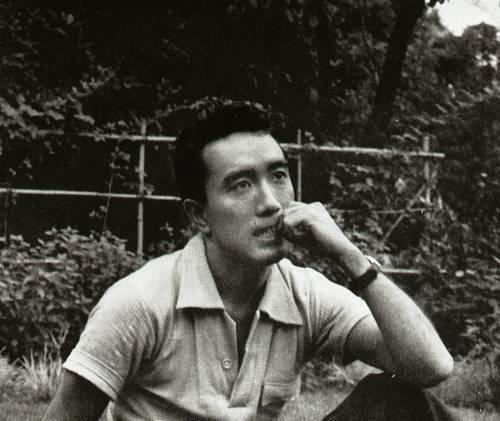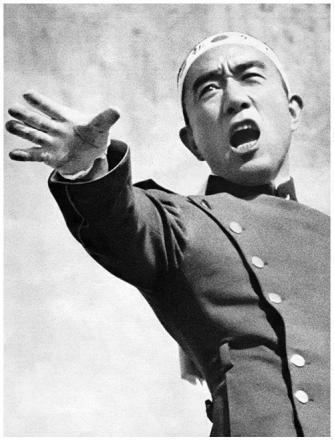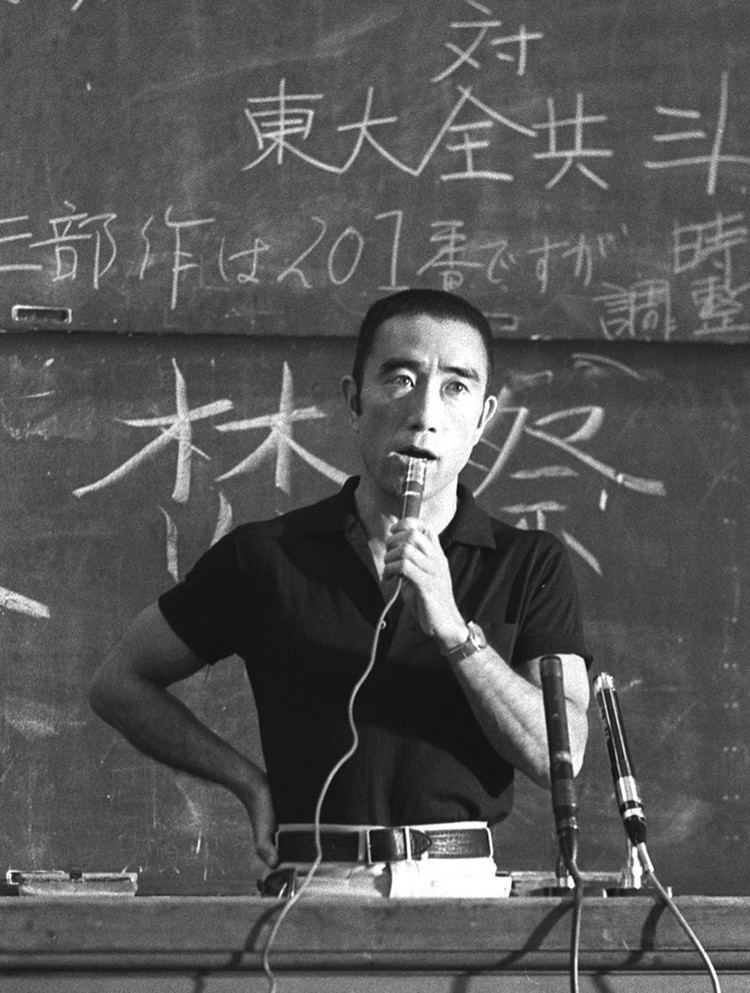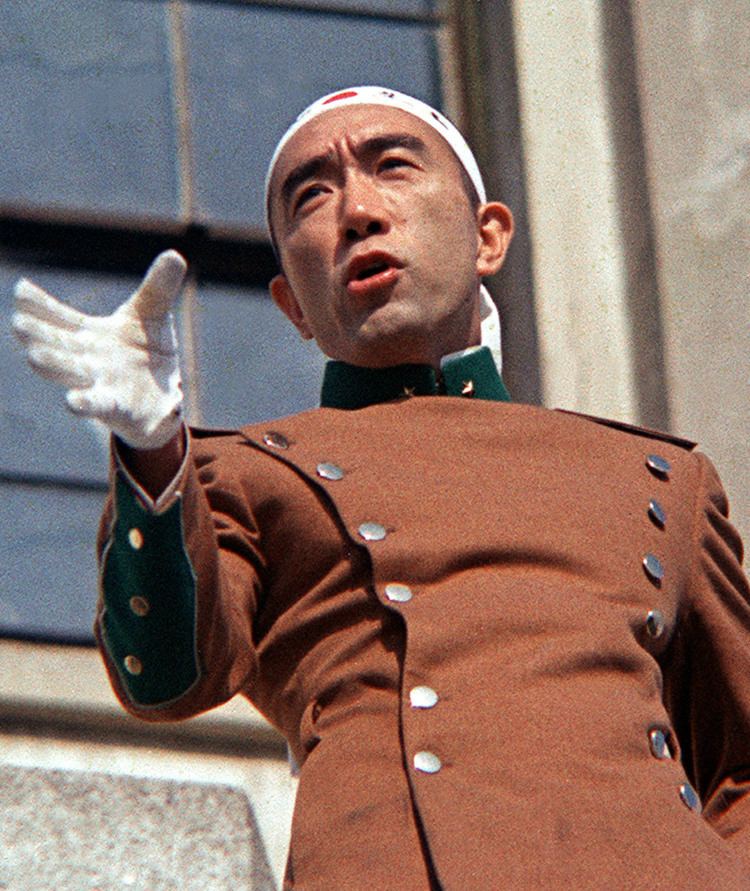Pen name Yukio Mishima Name Yukio Mishima Period 1941–1970 | Nationality Japanese Role Author | |
 | ||
Born Kimitake HiraokaJanuary 14, 1925Shinjuku, Tokyo, Japan ( 1925-01-14 ) Occupation Novelist, playwright, poet,short story writer,essayist, critic Spouse Yoko Hiraoka (m. 1958–1970) Movies Mishima: A Life in Four Chapters, Patriotism, Black Lizard Children Noriko Tomita, Iichiro Hiraoka Books The Temple of the Golde, Confessions of a Mask, Spring Snow, The Sound of Waves, The Sailor Who Fell from Grac Similar People | ||
My favourite author
1969 Interview with Yukio Mishima
Yukio Mishima (三島 由紀夫, Mishima Yukio) is the pen name of Kimitake Hiraoka (平岡 公威, Hiraoka Kimitake, January 14, 1925 – November 25, 1970), a Japanese author, poet, playwright, actor, and film director. Mishima is considered one of the most important Japanese authors of the 20th century. He was considered for the Nobel Prize in Literature in 1968 but the award went to his countryman Yasunari Kawabata. His works include the novels Confessions of a Mask and The Temple of the Golden Pavilion, and the autobiographical essay Sun and Steel. His avant-garde work displayed a blending of modern and traditional aesthetics that broke cultural boundaries, with a focus on sexuality, death, and political change. Mishima was active as a nationalist and founded his own right-wing militia, the Tatenokai. In 1970, he and three other members of his militia staged an attempted coup d'état when they seized control of a Japanese military base and took the commander hostage, then tried and failed to inspire a coup to restore the Emperor's pre-war powers. Mishima then committed ritual suicide by seppuku. The coup attempt became known as the "Mishima Incident".
Contents
- My favourite author
- 1969 Interview with Yukio Mishima
- Early life
- Schooling and early works
- Post war literature
- Acting and modelling
- Private life
- Coup attempt and ritual suicide
- Legacy
- Awards
- Plays for classical Japanese theatre
- Works about Mishima
- Ancestry
- References

The Mishima Prize was established in 1988 to honor his life and works.

Early life

Mishima was born in the Yotsuya district of Tokyo (now part of Shinjuku). His father was Azusa Hiraoka, a government official, and his mother, Shizue, was the daughter of the 5th principal of the Kaisei Academy. Shizue's father, Kenzō Hashi, was a scholar of Chinese classics, and the Hashi family had served the Maeda clan for generations in Kaga Domain. Mishima's paternal grandparents were Sadatarō Hiraoka and Natsuko (family register name: Natsu) Hiraoka. He had a younger sister, Mitsuko, who died of typhus in 1945 at the age of 17, and a younger brother, Chiyuki.

Mishima's early childhood was dominated by the presence of his grandmother, Natsuko, who took the boy, separating him from his immediate family for several years. Natsuko was the granddaughter of Matsudaira Yoritaka, the daimyō of Shishido in Hitachi Province, and had been raised in the household of Prince Arisugawa Taruhito; she maintained considerable aristocratic pretensions even after marrying Mishima's grandfather, a bureaucrat who had made his fortune in the newly opened colonial frontier in the north and who eventually became Governor-General of Karafuto Prefecture on Sakhalin Island. Through his grandmother, Mishima was a direct descendant of Tokugawa Ieyasu. Natsuko was prone to violence and morbid outbursts, which are occasionally alluded to in Mishima's works. It is to Natsu that some biographers have traced Mishima's fascination with death. Natsuko did not allow Mishima to venture into the sunlight, to engage in any kind of sport or to play with other boys; he spent much of his time alone or with female cousins and their dolls.
Mishima returned to his immediate family when he was 12. His father, a man with a taste for military discipline, employed parenting tactics such as holding the young boy up to the side of a speeding train. He also raided Mishima's room for evidence of an "effeminate" interest in literature and often ripped apart the boy's manuscripts.
Schooling and early works
At the age of six, Mishima enrolled in the elite Gakushūin, the Peers' School in Tokyo. At twelve, Mishima began to write his first stories. He voraciously read the works of numerous classic Japanese authors as well as Raymond Radiguet, Oscar Wilde, Rainer Maria Rilke and other European authors, both in translation and in the original. He studied German, French, and English. After six years at school, he became the youngest member of the editorial board of its literary society. Mishima was attracted to the works of the Japanese author Michizō Tachihara (1914–39), which in turn created an appreciation for classical Japanese poetry form of waka. Mishima's first published works included waka poetry, before he turned his attention to prose.
He was invited to write a short story for the Gakushūin literary magazine and submitted Hanazakari no Mori (花ざかりの森, "Forest in Full Bloom"), a story in which the narrator describes the feeling that his ancestors somehow still live within him. Mishima's teachers were so impressed that they recommended the story to the prestigious literary magazine Bungei-Bunka. The story makes use of the metaphors and aphorisms that later became his trademarks and was published in book form in 1944 in a limited edition (4,000 copies) because of the wartime shortage of paper. In order to protect him from a possible backlash from his schoolmates, his teachers coined the pen-name "Yukio Mishima".
Mishima's story Tabako (煙草, "The Cigarette"), published in 1946, describes some of the scorn and bullying he faced at school when he later confessed to members of the school's rugby union club that he belonged to the literary society. This trauma also provided material for the later story Shi o Kaku Shōnen (詩を書く少年, "The Boy Who Wrote Poetry") in 1954.
Mishima received a draft notice for the Imperial Japanese Army during World War II. At the time of his medical check up, he had a cold, and the young army doctor heard rales from the lung which was misdiagnosed as tuberculosis; Mishima was declared unfit for service.
Although his authoritarian father had forbidden him to write any further stories, Mishima continued to write every night in secret, supported and protected by his mother, who was always the first to read a new story. Attending lectures during the day and writing at night, Mishima graduated from the University of Tokyo in 1947. He obtained a position as an official in the government's Finance Ministry and was set up for a promising career. However, Mishima had exhausted himself so much that his father agreed to his resigning from the position during the first year of employment in order to devote himself to writing.
Post-war literature
Mishima wrote novels, popular serial novellas, short stories and literary essays, as well as highly acclaimed plays for the Kabuki theater and modern versions of traditional Noh drama. Mishima began the short story Misaki nite no Monogatari (岬にての物語, "A Story at the Cape") in 1945, and continued to work on it through the end of World War II. In January 1946, he visited famed writer Yasunari Kawabata in Kamakura, taking with him the manuscripts for Chūsei (中世, "The Middle Ages") and Tabako, and asking for Kawabata's advice and assistance. In June 1946, following Kawabata's recommendations, Tabako was published in the new literary magazine Ningen (人間, "Humanity").
Also in 1946, Mishima began his first novel, Tōzoku (盗賊, "Thieves"), a story about two young members of the aristocracy drawn towards suicide. It was published in 1948, placing Mishima in the ranks of the Second Generation of Postwar Writers. He followed with Confessions of a Mask, a semi-autobiographical account of a young homosexual who must hide behind a mask in order to fit into society. The novel was extremely successful and made Mishima a celebrity at the age of 24. Around 1949, Mishima published a series of essays in Kindai Bungaku on Yasunari Kawabata, for whom he had always had a deep appreciation.
His writing gained him international celebrity and a sizable following in Europe and the United States, as many of his most famous works were translated into English. Mishima traveled extensively; in 1952 he visited Greece, which had fascinated him since childhood. Elements from his visit appear in Shiosai (潮騒, "Sound of the Waves"), which was published in 1954, and drew inspiration from the Greek legend of Daphnis and Chloe.
Mishima made use of contemporary events in many of his works. The Temple of the Golden Pavilion published in 1956 is a fictionalization of the burning of the famous temple in Kyoto. Utage no ato ("After the Banquet"), published in 1960, so closely followed the events surrounding politician Hachirō Arita's campaign to become governor of Tokyo that Mishima was sued for invasion of privacy. In 1962, Mishima's most avant-garde work, Utsukushii hoshi ("Beautiful Star"), which at times comes close to science fiction, was published to mixed critical response.
Mishima was considered for the Nobel Prize for Literature three times and was a favorite of many foreign publications. However, in 1968 his early mentor Kawabata won the Nobel Prize and Mishima realized that the chances of it being given to another Japanese author in the near future were slim. In a work published in 1970, Mishima wrote that the writers he payed most attention to in modern western literature were Georges Bataille, Pierre Klossowski, and Witold Gombrowicz.
Acting and modelling
Mishima was also an actor, and had a starring role in Yasuzo Masumura's 1960 film, Afraid to Die. He also had roles in films including Yukoku (directed by himself, 1966), Black Lizard (directed by Kinji Fukasaku, 1968) and Hitokiri (directed by Hideo Gosha, 1969). He also sang the theme song for Afraid to Die (lyrics by himself; music by Shichirō Fukazawa).
Mishima was featured as a photo model in Ba-ra-kei: Ordeal by Roses by Eikoh Hosoe, as well as in Young Samurai: Bodybuilders of Japan and Otoko: Photo Studies of the Young Japanese Male by Tamotsu Yatō. American author Donald Richie gave a short lively account of Mishima, dressed in a loincloth and armed with a sword, posing in the snow for one of Tamotsu Yato's photoshoots.
Private life
In 1955, Mishima took up weight training and his workout regimen of three sessions per week was not disrupted for the final 15 years of his life. In his 1968 essay Sun and Steel, Mishima deplored the emphasis given by intellectuals to the mind over the body. Mishima later also became very skilled at kendo, traditional Japanese swordsmanship.
After briefly considering a marital alliance with Michiko Shōda (who later married Crown Prince Akihito and is now Empress Michiko), Mishima married Yoko Sugiyama on June 11, 1958. The couple had two children: a daughter named Noriko (born June 2, 1959) and a son named Iichiro (born May 2, 1962).
While working on Forbidden Colors, Mishima visited gay bars in Japan. Mishima's sexual orientation was an issue that bothered his widow, and she always denied his homosexuality after his death. In 1998, the writer Jiro Fukushima published an account of his relationship with Mishima in 1951, including fifteen letters between himself and the famed novelist. Mishima's children successfully sued Fukushima for violation of his privacy and copyright.
In 1967, Mishima enlisted in the Ground Self Defense Force (GSDF) and underwent basic training. A year later, he formed the Tatenokai ("shield society"), a private militia composed primarily of young students who studied martial principles and physical discipline, and swore to protect the Emperor of Japan. Mishima trained them himself. However, under Mishima's ideology, the emperor was not necessarily the reigning Emperor, but rather the abstract essence of Japan. In Eirei no Koe ("Voices of the Heroic Dead"), Mishima denounced Emperor Hirohito for renouncing his claim of divinity after World War II, arguing that millions of Japanese had died in the war for their "living god" Emperor, and that the Showa Emperor's renouncing his divinity meant that all those deaths were in vain.
In the final ten years of his life, Mishima wrote several full-length plays, acted in several films, and co-directed an adaptation of one of his stories, Patriotism, the Rite of Love and Death. He also continued work on his final tetralogy, The Sea of Fertility (Hōjō no Umi), which appeared in monthly serialized format from September 1965.
Mishima espoused a very individual brand of nationalism towards the end of his life. He was hated by leftists, in particular for his outspoken commitment to bushido, the code of the samurai, and by mainstream nationalists for his contention, in Bunka Bōeiron (文化防衛論, "A Defense of Culture"), that Hirohito should have abdicated and taken responsibility for the loss of life in the war.
Coup attempt and ritual suicide
On November 25, 1970, Mishima and four members of the Tatenokai, under pretext, visited the commandant of the Ichigaya Camp, the Tokyo headquarters of the Eastern Command of the Japan Self-Defense Forces. Inside, they barricaded the office and tied the commandant to his chair. With a prepared manifesto and a banner listing their demands, Mishima stepped onto the balcony to address the soldiers gathered below. His speech was intended to inspire a coup d'état to restore the power of the emperor. He succeeded only in irritating the soldiers, and was mocked and jeered. He finished his planned speech after a few minutes, returned to the commandant's office and committed seppuku. The assisting kaishakunin duty at the end of this ritual (to decapitate Mishima) had been assigned to Tatenokai member Masakatsu Morita, who was unable to properly perform the task. After several failed attempts at severing Mishima's head, he allowed another Tatenokai member, Hiroyasu Koga, to behead Mishima. Morita then knelt and stabbed himself in the abdomen and Koga again performed the kaishakunin duty. This coup is called "Mishima jiken" (三島事件, "Mishima Incident") in Japan.
Another traditional element of the suicide ritual was the composition of so-called death poems before their entry into the headquarters. Mishima planned his suicide meticulously for at least a year and no one outside the group of hand-picked Tatenokai members had any indication of what he was planning. His biographer, translator John Nathan, suggests that the coup attempt was only a pretext for the ritual suicide of which Mishima had long dreamed. Mishima made sure his affairs were in order and left money for the legal defense of the three surviving Tatenokai members.
Mishima's grave is located at the Tama Cemetery in Fuchū, Tokyo.
Legacy
Much speculation has surrounded Mishima's suicide. At the time of his death he had just completed the final book in his Sea of Fertility tetralogy. He was recognized as one of the most important post-war stylists of the Japanese language. Mishima wrote 34 novels, about 50 plays, about 25 books of short stories, and at least 35 books of essays, one libretto, as well as one film.
A 1985 biographical film by Paul Schrader titled Mishima: A Life in Four Chapters depicts his life and work; however, it has never been given a theatrical presentation in Japan.
On July 3, 1999, "Mishima Yukio Bungaku-kan" (三島由紀夫文学館, "Mishima Yukio Literary Museum") was opened in Yamanakako.
Awards
Plays for classical Japanese theatre
In addition to contemporary-style plays such as Madame de Sade, Mishima wrote for two of the three genres of classical Japanese theatre: Noh and Kabuki (as a proud Tokyoite, he would not even attend the Bunraku puppet theatre, always associated with Osaka and the provinces).
Though Mishima took themes, titles and characters from the Noh canon, his twists and modern settings, such as hospitals and ballrooms, startled audiences accustomed to the long-settled originals.
Donald Keene translated Five Modern Noh Plays (Tuttle, 1981; ISBN 0-8048-1380-9). Most others remain untranslated and so lack an "official" English title; in such cases it is therefore preferable to use the rōmaji title.
Works about Mishima
Ancestry
Incorporates information from the Japanese Wikipedia article
